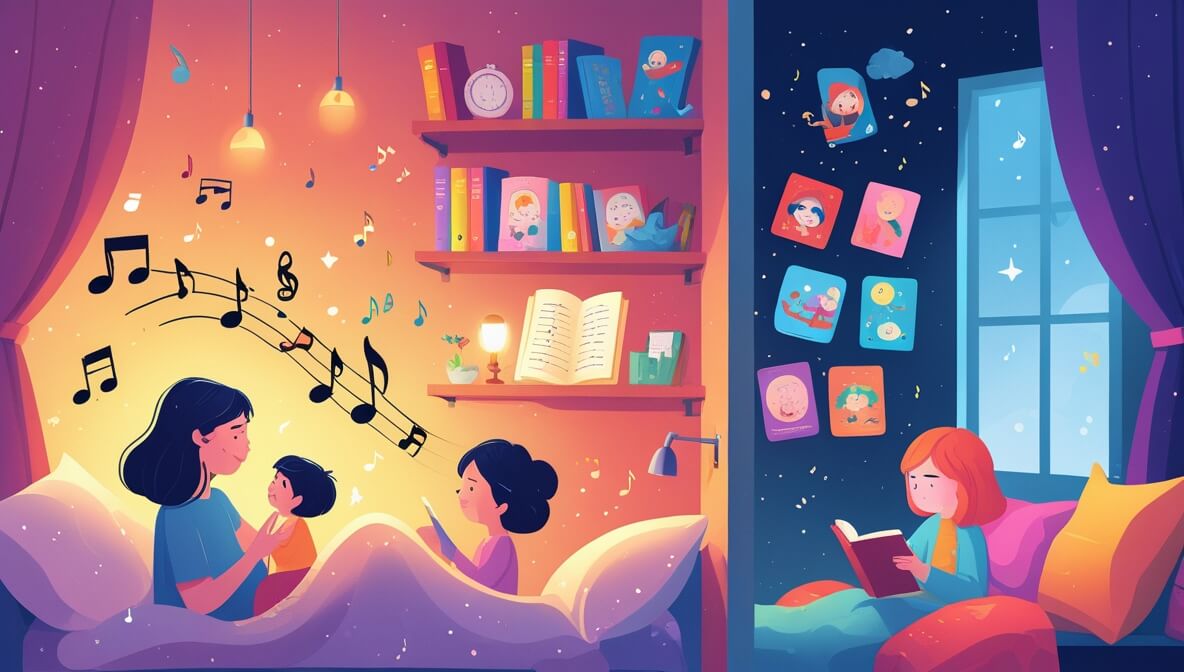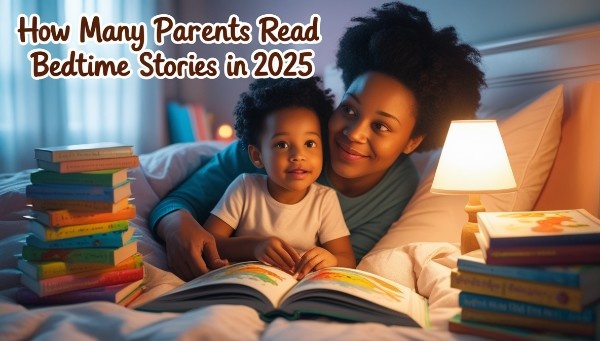Transitioning from traditional lullabies to bedtime stories is becoming more prevalent, raising the question of whether these narratives can effectively replace the soothing songs of old. This blog explores the benefits, implications, and potential of this bedtime evolution, offering insights into how storytelling might impact children’s emotional well-being and sleep patterns.
Bedtime rituals are a longstanding tradition in nurturing children, with lullabies historically serving as a soothing tool to ease young minds into sleep.
However, as storytelling gains popularity, parents are increasingly considering bedtime stories as a potential substitute for lullabies. This shift prompts an exploration of how storytelling influences children’s rest and emotional health.
Can Bedtime Stories Actually Replace Lullabies?
Bedtime rituals set the tone for a peaceful night.
Parents often debate whether a story can stand in for a song.
To answer the question can bedtime stories replace lullabies, we need to explore how each ritual works, what they offer and why both hold a special place in childhood.
Bedtime Stories vs. Lullabies: A Quick Overview
Bedtime stories and lullabies seem similar at first glance, but they serve different functions.
Lullabies use rhythm and melody to calm the body, while bedtime stories engage the mind and spark imagination.
Understanding these differences helps parents decide whether to swap one for the other or weave them together.
What Makes Lullabies Special?
Physiological and Emotional Benefits of Lullabies
Lullabies are more than soothing tunes.
Researchers at Great Ormond Street Hospital in London found that hospitalized children experienced decreased heart rates and less pain when listening to lullabies, whereas reading aloud or silence did not produce the same calming effect[1].
This suggests that music engages emotional centers in the brain, lowering arousal and promoting relaxation[1].
In other studies, relaxing classical music improved sleep quality and reduced sleeping problems[2].
Music therapy also reaches deep into the limbic system, releasing emotional tension and easing discomfort[1].
These physiological effects show why lullabies remain a staple in soothing infants and toddlers.
Universal Appeal and Bonding
Lullabies transcend language and culture.
Harvard’s Music Lab discovered that American infants relaxed when listening to lullabies sung in unfamiliar languages; their heart rates and pupil dilation decreased while their overall arousal dropped[3].
This universal response highlights the innate soothing power of lullabies.
Beyond calming, singing strengthens connections.
Laura Cirelli’s research shows that singing lowers stress levels for both babies and caregivers, especially when the song is familiar[4].
The combination of a caregiver’s voice, eye contact and gentle rocking fosters secure attachment and reduces anxiety[4].
Lullabies even support early development.
Zero to Three notes that singing a lullaby while rocking a baby stimulates early language skills and spatial awareness[5].
The Canadian Paediatric Society adds that the repetitive structure and rhythm of songs help infants develop phonological awareness and prepare for later reading[6].
Why Parents Love Bedtime Stories
Sleep Benefits of Storytime
Reading before bed isn’t just cozy; it can improve sleep.
Research cited by Sleep.com shows that preschoolers who hear a bedtime story sleep longer and better.
Integrating stories into the bedtime routine also reduces bedtime resistance and helps children relax.
Physical books provide another advantage: they lack the blue light emitted by screens, so they don’t suppress melatonin production.
This makes reading a healthier wind‑down option compared to digital devices.
Bonding and Emotional Growth
Bedtime stories create meaningful moments of connection.
Snuggling up with a parent and listening to a tale fosters closeness and security.
Studies show that foster children adjust more easily to new homes when caregivers include reading in a calming bedtime routine.
Cognitive and Language Development
Reading is an investment in a child’s future.
Studies presented at the Pediatric Academic Societies meeting indicate that reading to infants enhances vocabulary and reading skills years later.
Shared reading develops print awareness and narrative understanding, while brain scans of preschoolers show that storytime activates regions responsible for mental imagery and narrative compression.
Bedtime stories may even “rewire” the brain’s language centers.
A study summarized by Otsimo found that after eight weeks of reading and literacy exercises, children who struggled with reading showed brain activity similar to proficient readers.
Reading also builds vocabulary, listening skills and comprehension [7].
Comparing Bedtime Stories and Lullabies
Unique Roles in the Sleep Routine
Lullabies work directly on the body’s rhythms.
They align with a relaxed heartbeat and help regulate breathing, often putting babies to sleep more quickly[8].
They also release oxytocin—sometimes called the “cuddle hormone”—which strengthens bonding[9].
Stories, on the other hand, calm the mind.
They offer a gentle transition from the activity of the day to the quiet of the night.
By occupying a child’s imagination, stories signal that it’s time to rest without overstimulating the senses[8].
Why They’re Not Interchangeable
Replacing lullabies with stories may leave a gap in the bedtime routine.
The physiological relaxation that music provides—slower heart rate, reduced pain and lower arousal[1]—is not replicated by reading alone.
Likewise, the oxytocin release and tactile interaction of singing cannot be matched by storytelling[9].
Conversely, skipping bedtime stories means missing out on language development, mental imagery and narrative skills.
A lullaby cannot introduce new vocabulary or teach how stories work.
Thus, each ritual offers distinct benefits that complement rather than substitute one another.
Should You Replace Lullabies with Bedtime Stories?
Expert Insights and Research
Experts generally advise against swapping out lullabies entirely.
Health organizations like the Canadian Paediatric Society recommend combining singing and reading to maximize benefits[10].
Singing engages attention and prepares the brain for language, while reading enhances literacy and emotional regulation.
Researchers at Yale found that increasing the amount of singing parents do leads to measurable improvements in infant mood, independent of immediate music exposure[11].
This suggests that regular singing has long‑term benefits.
Meanwhile, reading has been linked to improved sleep quality in both children and adults[12].
Balancing Both Rituals
An effective bedtime routine can feature both a song and a story.
For younger babies, begin with a lullaby while rocking; the rhythmic melody calms the body and signals that sleep is near.
As your child starts to relax, transition into a short story to engage their imagination and lay the foundation for language skills.
For older children, you might reverse the order—read a book, then sing a calming lullaby as lights dim.
This combination maintains the benefits of music while allowing storytime to remain a cherished part of the routine.
Practical Tips for Parents
Crafting Your Bedtime Routine
- Keep it consistent: Choose a sequence of activities—bath, lullaby, story—that you repeat each night.
Predictability helps children feel secure and signals that bedtime is approaching. - Match the child’s age: Younger infants may benefit more from gentle singing and rocking, while toddlers and preschoolers enjoy interactive stories.
- Use song‑based books: Picture books that incorporate songs or rhymes blend the benefits of music and reading.
- Stay engaged: Make eye contact, vary your voice and involve your child in the story.
Shared reading and singing are about connection, not perfection.
<p>
When to Transition
As children grow, their needs evolve.
You might rely heavily on lullabies during the first year and gradually introduce more storytime as language skills develop.
There’s no strict timetable—follow your child’s cues and adapt the routine accordingly.
Conclusion: The Best of Both Worlds
So, can bedtime stories replace lullabies? The answer is that they shouldn’t have to.
Lullabies calm the body, release feel‑good hormones and create secure bonds[1][13].
Bedtime stories stimulate the mind, build language skills and help children drift off peacefully[14].
By blending both rituals, parents can craft a bedtime routine that nurtures their child’s physical comfort and intellectual growth.
Embracing this dual approach ensures your little one drifts off feeling loved, inspired and ready for sweet dreams.
Frequently Asked Questions
What are the main benefits of bedtime stories for children?
Bedtime stories offer numerous benefits for children, including the stimulation of their imagination and cognitive development. Listening to stories encourages children to visualize characters and settings, which can enhance their language skills and comprehension. Furthermore, stories provide an opportunity for family bonding and impart important moral lessons. This shared experience can transform bedtime into a cherished family tradition, strengthening emotional ties.
Can bedtime stories completely replace lullabies?
While bedtime stories can serve as an effective alternative to lullabies for some children, they might not completely replace them for everyone. The choice largely depends on individual preferences and needs. Some children might find stories to be a perfect blend of entertainment and relaxation, while others may still prefer the melodic comfort of lullabies. The key is to discover a balance that works best for the child and supports their emotional and cognitive development.
How do bedtime stories support emotional development?
Bedtime stories can significantly support emotional development by providing a safe space for children to explore different emotions. Through characters and plots, children learn about empathy, kindness, and resilience. Stories can also help address common childhood fears and anxieties, offering reassurance and fostering coping mechanisms. This emotional engagement is beneficial in developing emotional intelligence and social skills.
Why are lullabies traditionally used in bedtime routines?
Lullabies have been a traditional component of bedtime routines due to their soothing qualities. The melody and rhythm of lullabies can establish a sense of security and comfort, making it easier for children to transition into sleep. Their repetitive nature helps create a consistent sleep routine, which is crucial for healthy sleep patterns. Lullabies provide a unique form of melodic comfort that can be especially calming for young minds.
What role do parents play in bedtime storytelling?
Parents have a vital role in bedtime storytelling by selecting stories that align with their children’s interests and values. This selection process allows parents to impart valuable life lessons and reinforce positive behaviors. The interactive nature of storytelling encourages discussion and reflection, enhancing communication skills and deepening understanding between parent and child. Storytelling also offers an opportunity for parents to bond with their children and create lasting memories.
How do bedtime routines affect sleep quality in children?
Consistent bedtime routines are essential in signaling to the brain that it’s time to sleep, which can improve sleep quality and duration. Routines that incorporate stories and lullabies can create a sense of predictability and security, helping children wind down at the end of the day. The familiar rhythms of a lullaby or the engaging narrative of a story can serve as cues for the brain to transition into sleep mode, fostering restful and restorative sleep.
How can parents find the right balance between stories and lullabies?
Finding the right balance between stories and lullabies involves observing how a child responds to different bedtime rituals. Parents can experiment with incorporating both elements into the routine, using stories to engage the mind and lullabies to soothe the senses. Paying attention to the child’s preferences and adjusting as needed can help create a holistic bedtime experience that nurtures emotional and cognitive development, while promoting restful sleep.
The Benefits of Playing Music to Children at Bedtime
https://www.thetabernaclechoir.org/articles/benefits-of-playing-music-to-children-at-bedtime.html
Research shows lullabies in any language relax babies — Harvard Gazette
What the Lullabies We Sing to Our Children Reveal About Us
Beyond Twinkle, Twinkle: Using Music with Infants and Toddlers | ZERO TO THREE
Read, speak, sing: Promoting early literacy in the health care setting – PMC
https://pmc.ncbi.nlm.nih.gov/articles/PMC8077210/
The Benefits of Bedtime Stories for Kids | Sleep.com
https://www.sleep.com/sleep-health/benefits-of-bedtime-reading-for-kids
How Do Bedtime Stories Improve Language Skills for Kids? | Otsimo
https://otsimo.com/en/how-do-bedtime-stories-improve-language-skills-for-kids/
The Science of Lullabies: How They Support Baby Development
https://cocomoonhawaii.com/blogs/blog/the-science-of-lullabies-how-they-support-baby-development
Why Lullabies Work, According to the Experts | ParentCo.
https://www.parent.com/blogs/conversations/2023-lullabies-work-according-experts
Singing to Babies Improves Their Moods < Yale School of Medicine
https://medicine.yale.edu/news-article/singing-to-babies-improves-their-moods/
Reading to Kids at Night Leads to Better Sleep for Everyone: Study
https://sleepopolis.com/news/reading-to-kids-before-bed-benefits/










